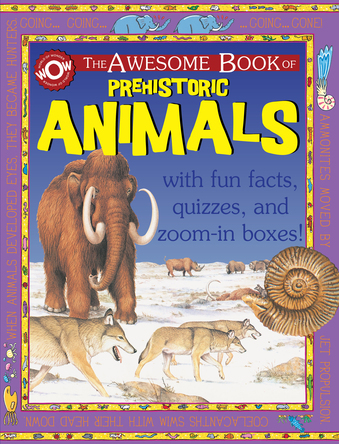Extrait du livre Prehistoric Animals
Get ready to hear your kids say, “Wow! That’s awesome!” as they dive into this fun, informative, question-answering series of books! Students—and teachers and parents—will learn things about the world around them that they never knew before! This approach to education seeks to promote an interest in learning by answering questions kids have always wondered about. When books answer questions that kids already want to know the answers to, kids love to read those books, fostering a love for reading and learning, the true keys to lifelong education. Colorful graphics are labeled and explained to connect with visual learners, while in-depth explanations of each subject will connect with those who prefer reading or listening as their learning style. This educational series makes learning fun through many levels of interaction. The in-depth information combined with fantastic illustrations promote learning and retention, while question and answer boxes reinforce the subject matter to promote higher order thinking. Teachers and parents love this series because it engages young people, sparking an interest and desire in learning. It doesn’t feel like work to learn about a new subject with books this interactive and interesting. This set of books will be an addition to your home or classroom library that everyone will enjoy. And, before you know it, you, too, will be saying, “Wow! That’s awesome!” “People cannot learn by having information pressed into their brains. Knowledge has to be sucked into the brain, not pushed in. First, one must create a state of mind that craves knowledge, interest, and wonder. You can teach only by creating an urge to know.” - Victor Weisskopf
Introduction During the history of Earth, there have been far more extinct animals than there are living ones today. In fact, life was almost wiped out before it had a chance to get going. When life began many millions of years ago, there was little oxygen in the atmosphere. All early plant-like life forms relied on other gases to breathe. But as they grew, they produced oxygen, which had the effect of poisoning them. This was the first mass extinction on the planet. Then, some survivors began to use oxygen as animals do today. Over time, many different species evolved to occupy about the truly weird and animals every place on the planet. Q: Why watch out for these boxes? A: They give answers to the questions you always wanted to ask about prehistoric animals. Bits and Pieces Look out for these boxes to take a closer look at prehistoric animal features. Awesome Facts Watch out for these diamonds to learn more wonderful facts about prehistoric and their world.
Crocodiles look the same now as in dinosaur times. Endangered and Extinct As life evolved, primitive animal species were gradually replaced by more refined versions, like the species we see today. The ancient species became extinct—they disappeared forever. Now, many modern species are also threatened with extinction. Sharks, for example, have a 400-million-year-old history, yet several species are now endangered. SYMBOL DEFINITIONS In this book, the red X symbol shows an animal that is already extinct. The yellow exclamation point shows an Mammoth animal whose ancestors have been around since prehistoric times, but is now endangered. (This means that there are a few animals of that species left in the wild.) The green Great white shark check shows an animal that has survived from prehistoric Coelacanth times. Many of these ancient animals have only recently been rediscovered, but most are still endangered species. Q: Why do animals become extinct today? A: Various reasons: destruction of their habitat, removal of their food, overhunting, pollution, or general disturbance that prevents them from breeding. Disturbance can be in the form of “alien” animals, like rats or cats, which are introduced to previously isolated places, such as islands. The aliens compete with or kill the defenseless residents. If overcrowded, animals might cross the sea or a mountain range to see if conditions are better on the other side. If they are, the animals will thrive and may develop skills that the original population lacks. In this way, they may become a new species. The new arrivals will compete with local residents and, if they are better equipped, they will often survive while the residents die out. There were times in prehistory when entire families of species were wiped out as the result of a great catastrophe. It is thought that a meteorite hitting the Earth from space was responsible for the dinosaurs dying out. A species confined to a small area can be wiped out completely just by a flash flood, forest fire, or violent storm. This happened recently in South America: several captive-bred golden lion tamarins (endangered) were released into a forest. There later was a terrible fire there, which almost killed them all.
Fossils are a record of evolution’s “winners” and “losers.” What is prehistory ? Prehistory is the time before history—before people began to keep written records of events that influenced their lives. It was also before people affected the state of the planet, when evolution and extinction were purely natural events. We know about prehistory through fossils, the remains of ancient life buried in layers of rock. The ancient Earth was very different from the planet today. The climate and geology (rock formation) have changed often during prehistory, and it is still changing. Weather patterns have shifted, the continents have moved and collided, mountains have risen and been eroded (worn down), and periods of increasing or decreasing ice cover have caused huge variation in sea levels. All these physical events have affected life on Earth, causing some species to die out, but also helping others to survive. Evolution happens in bursts. Long periods of stability lead to animals growing bigger and more specialized. When conditions change, these “specialists” are unable to adapt. The long, stable periods are punctuated by short, sharp shocks that kill off hundreds of species. This enables more adaptable “generalist” species to emerge, develop, and be successful. Hidden in the rocks are fossils, the stony evidence of what lived in prehistoric times. The rocks in which fossils are found are like a layer of cake, with each layer representing a different period of time. The upper layers are the youngest and contain the most recent fossils. The oldest are at the bottom. Each period had its own dominant animals. The Cambrian period was when all the groups of animals we see today first evolved. The Devonian was the age of fish, and the Jurassic the age of reptiles. We are now in the Holocene epoch (section) of the Quaternary period, and humans dominate the planet. Scientists group the periods into longer stretches of time called “eras.” Each era covers hundreds of millions, sometimes billions, of years. The first 4 billion years of Earth’s history is called the “Precambrian era.”
Hunting developed when animals evolved eyes. Early Experiments About 510 MYA, there was an evolutionary “tryout” period, when all the main groups of animals we see today first appeared. Some of these early arrivals survived and evolved into new species. Others were an evolutionary “dead end” and became extinct. Their fossil remains have been found in the ancient rocks of the Burgess Shale in Canada. Hallucigenia This segmented creature looked like a type of worm that walked on two rows of tentacle-like feet. It had spikes along its back, which it used to defend itself. Its actual shape and number of spikes are still being researched. Marrella was the first Burgess Shale animal to be found. It is nicknamed the “lace crab” because of its delicate legs and gills. Q: How did the Burgess Shale animals die? A: The animals were trapped by underwater mudflows that swept them off their shallow reefs and into deep water, where they were buried. They are perfectly preserved—including all the soft parts—because they were not exposed to oxygen or bacteria. Anomalocaris was the terror of the Cambrian seas. It was a predator, with a hard outer shell, a backbone, and a circular mouth on its underside. Two grasping arms caught its prey. It was about 6.5 feet (2 meters) long, making it the largest animal of its time. Opabinia was a five-eyed, segmented animal that crawled on the sea bottom. It had a fluid-filled arm on the front of its head, like a vacuum cleaner. It ate bits and pieces that it found in the mud. Odontogriphus was about 2.5 inches (6 centimeters) long, and had tiny tentacles and tooth-like structures at its front end. Awesome Facts Anomalocaris was first thought to be three animals. It had mouthparts like a jellyfish, a body like a sponge, and arms like a shrimp.
Ammonites and belemnites moved by squirting water out behind them. Primitive Sea Creatures Some of the early sea creatures were protected by shells or hard bodies, like shellfish and sea urchins have today. These animals survived for many millions of years, but were gradually knocked out by mass extinction events (see page 18). Living fossils Animals alive today that closely resemble those that lived many millions of years ago are known as “living fossils.” One living fossil is the pearly nautilus (below), which looks like an ammonite. These animals have been in the evolutionary slow lane, changing gradually over time. Belemnites were squid-like predators, with a soft body surrounding a bullet-shaped shell. They had tentacles at one end, but they were armed with hooks rather than suckers. They died out with the dinosaurs about 65 MYA. Trilobites were hard-shelled, segmented creatures that were shaped like modern wood lice or horseshoe crabs. They first appeared about 540 MYA, and developed into the most diverse (varied) group of animals. There were trilobite meat eaters and plant eaters. They became extinct 300 million years later. Ammonites were related to octopi and squid. They had a spiral shell divided into sections called “buoyancy chambers,” which enabled the ammonite to float. Ammonites disappeared 65 MYA. Cystoids were globular echinoderms (spiny-bodied animals) on stalks. They were attached to the seabed and lived in small colonies in shallow water. They disappeared about 250 MYA. Brachiopods are clam-like animals. They were once abundant, but about 250 MYA, 12,000 species were wiped out. Today, just 325 species survive in the deep sea and in polar waters.



























